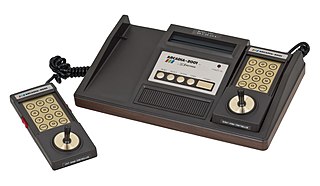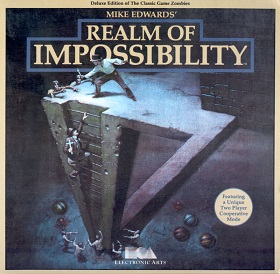Related Research Articles

The Arcadia 2001 is a second-generation 8-bit home video game console released by Emerson Radio in May 1982 for a price of US$ 99, several months before the release of ColecoVision. It was discontinued only 18 months later, with a total of 35 games having been released. Emerson licensed the Arcadia 2001 to Bandai, which released it in Japan. Over 30 Arcadia 2001 clones exist.

HAL Laboratory, Inc., formerly shortened as HALKEN, is a Japanese video game developer founded on 21 February 1980. While independent, it has been closely tied with Nintendo throughout its history, and is often referred to as a second-party developer for the company. HAL Laboratory is headquartered in Chiyoda, Tokyo, and it also has a building at Kai, Yamanashi. The company got its name because "each letter put them one step ahead of IBM". The company is most famous for their work on the Kirby and Mother series, as well as the first two Super Smash Bros. games.

Realm of Impossibility is an action game created by Mike Edwards for the Atari 8-bit family and published by Electronic Arts in 1984. It was originally released in 1983 as Zombies and published by BRAM, a company formed by Edwards and a friend. BRAM previously developed and published Attack at EP-CYG-4.
The following article is a broad timeline of arcade video games.

In computing, procedural generation is a method of creating data algorithmically as opposed to manually, typically through a combination of human-generated content and algorithms coupled with computer-generated randomness and processing power. In computer graphics, it is commonly used to create textures and 3D models. In video games, it is used to automatically create large amounts of content in a game. Depending on the implementation, advantages of procedural generation can include smaller file sizes, larger amounts of content, and randomness for less predictable gameplay. Procedural generation is a branch of media synthesis.

Webfoot Technologies is an American developer of personal computer games and video games for various platforms. Titles developed include Hello Kitty: Happy Party Pals and various Dragon Ball Z games for the Game Boy Advance.

Dungeons of Daggorath is one of the first real-time, first-person perspective role-playing video games. It was produced by DynaMicro for the TRS-80 Color Computer in 1983. A sequel, Castle of Tharoggad, was released in 1988.

Heiankyo Alien, known as Digger in North America, is a maze video game created by The University of Tokyo's Theoretical Science Group (TSG) in 1979. The game was originally developed and released as a personal computer game in 1979, and was then published by Denki Onkyō Corporation as an arcade game in November 1979. In 1980, the arcade game was released in North America as Digger by Sega-Gremlin, with minor changes in appearance.

The first hobbyist-developed game for the Atari 2600 video game console was written in 1995, and more than 100 have been released since then. The majority of games are unlicensed clones of games for other platforms, and there are some also original games and ROM hacks. With only 128 bytes of RAM, no frame buffer, and the code and visuals closely intertwined, the 2600 is a difficult machine to program. and many games were written for the technical challenge. Emulators, programming tools, and documentation are available.
References
- ↑ Komar, Charlene (June 1983). "Mole Attack". Electronic Games. p. 70. Retrieved 6 January 2015.